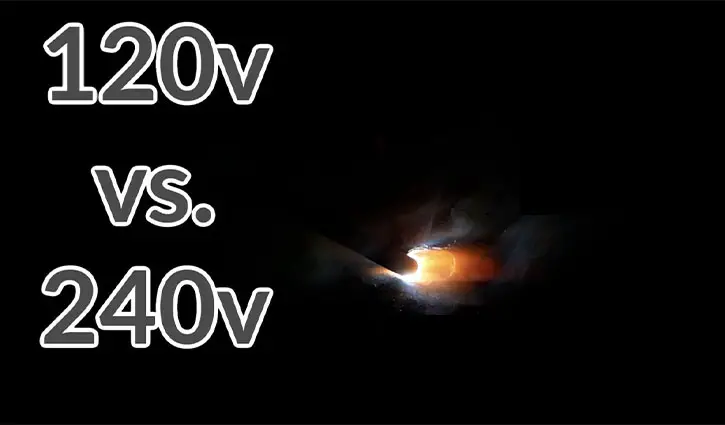You know welding is an essential part of the metal fabrication process. So, a daily life user and welding enthusiast must be more familiar with welding machines. However, 120v and 240v welders are the two available types of welders you will find in the market.
120v welder is the standard type and 240v welder is a more robust one. From the voltage, it is obvious that 240v is a more capable one. But having more voltage does not make it suitable for all applications.
To know more about 120v and 240v welders, their differences, and their similarities, let’s take a look at the full article. It may help you choose the best suitable one for your application.
Comparison Table on 120v vs 240v welder
| Topic | 120v welder | 240v welder |
| Power consumption | Consumes approximately 3000 watts | Consumes approximately 5000 watts |
| Welding capability | Capable of doing light welding | Capable of doing heavy welding |
| Thickness | Up to 6.35 mm | Up to 12.7 mm |
| Application | Simple projects or household works | Industrial works |
What stands for 120v Welder
A 120v welder is a basic welding machine that is used for joining two metal or thermoplastics parts together. A 120v welder performs its operation utilizing 120-volt input and is suitable for use around houses or farms.
240v Welder
A 120v welder is a powerful welding machine that is mostly used for industrial applications or professional work. A 120v welder is a more capable machine and able to weld thicker metals than a 120v welder.
Read More: Basic Welding Positions: Definition And Features Of These Welding Positions
Difference Between 120v and 240v welder
The Welded machine allows users to join metal parts with great strength and accuracy. Based on power input, two types (120v and 240v) of welding machines are available in the market.
Let’s take a look at their core differences which may help you find the suitable one for your job.
Power consumption
120v welder– It consumes almost 3000 watts depending on the amperage rating.
240v welder– It initially uses 6000 watts to start and later the energy rate reduces to 5000 watts.
Welding capability
120v welder- It is capable of welding 0.8 mm to 6.35 mm which is good enough for a simple project or household application.
240v welder– As 240v utilizes more power, its welding capability will also be higher. It can weld 12.7 mm thick metals.
Cost
120v welder- A typical 120-Volt, 90-Amp welder will cost around $200.
240v welders- 200v welders are a little bit more costly. It may cost around $600 depending on the brand.
120v vs 240v weld strength
Well, the answer is quite complicated. If the thickness of the material is within the limit of both 120v and 240v welders, then the welding will be of equal strength. But if you push the limit of the welding machine, both machines tend to produce weaker welds.
As a 120v welder possesses a lower thickness limit in welding, it may produce weaker welds while welding thicker metals compared to a 240v welder.
Does a 240V welder work better than 120V on thin steel?
To be honest, 240v doesn’t have any extra advantage on thin steel. On thin steel, both 120v and 240v welders will do a great job. Any practical differences will hardly be noticeable on thin steel.
But 240v will offer better capabilities and extra power in case of heavy welding. A 240v welder also offers heavy-duty cycles even if the small operation is performed. But the operating cost will eventually increase as the energy required to run a 240v welding machine is higher.
120v vs 240-volt welder: Which one is best for me?
Well, the 240v welder is substantially superior to the 120v welder. But this doesn’t make a 240v welder perfect for all applications. To choose one, you have to go through your requirements, priorities, and considerations.
Although the 120v welder has thickness limitations, it performs pretty well for a simple fabrication process. So, to work around a house or farm, a 120v welder will do the same job as a 240v welder. Moreover, a 120v welder will save you a decent amount over time. In some places, a 240v electricity line is not accessible whereas a 120v welder is the only option.
A 240v welder does a better job in welding both thick and thin metal. Although the heat affected area will be more compared to 120v welder. For professional uses or industrial applications, the 240v welder performs better.
And also, if you have access to a 240V line and want to weld thick metal parts, you may go for a 240v welder.
FAQs
High voltage will melt the base metal while welding and the filler metal will not be enough to fill the gap. Eventually, this will result in an undercut.
The arc length of the welding depends on the voltage input. The arc length increases with the increase of voltage. It also helps the weld to be flat. But it has little effect on penetration.
Well, plugging a 120v welder into a 240V line will melt or burn the machine. As the higher voltage is applied, the machine will draw more current, and more heat will be generated. Eventually, the machine will be burnt out.
Read More: Gas Welding Vs Arc Welding: A Complete Comparison, Difference
Verdict
Both 120v and 240v welders are capable of performing their job pretty well. 120v welder is suitable for the fabrication of sheet metals and simple projects. Hence, the 240v welder performs well for industrial applications and professional uses but the operating cost is high.
So, you have to choose one based on your requirements.
